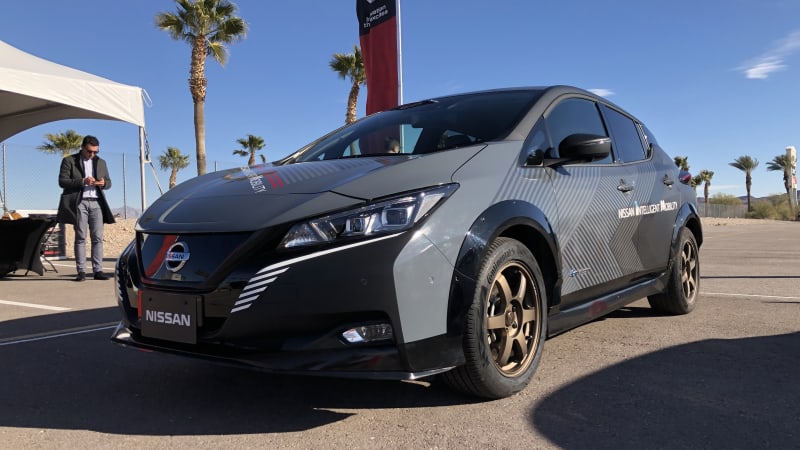Audi Repair Shop Doylestown
Call 267 279 9477 to schedule a appointment

Compromise used to be the unfortunate truth in auto manufacturing. The hardware needed to build an enthusiast-pleasing machine wasn’t necessarily compatible with producing a comfortable, safe vehicle. With the advent of modern electric vehicles, this situation is changing, and our recent drive of Nissan’s e-4ORCE prototype all-wheel drive system shows how.
The vehicle in question is a regular Nissan Leaf Plus that’s been outfitted with two Leaf Plus motors (one in front and one in back) and Nissan’s e-4ORCE all-wheel drive system. A variety of tests were laid out for us at the Las Vegas Motor Speedway during CES last week to let us try out Nissan’s new dual-motor EV system. Turns out, e-4ORCE offers more than just increased traction.
All the proof is in the driving. Our first test was a straight-line acceleration run. Two Leaf Plus motors combine for a system output of 304 horsepower and 502 pound-feet of torque. To put it lightly, the e-4ORCE test car made the regular Leaf Plus feel as though it was hardly moving. The quick response from the go-pedal was just as impressive — Nissan claims its powertrain responds quicker than any other dual-motor EV system that it benchmarked.
Next up, Nissan had us experience the benefit of rear motor regenerative braking. Instead of a swift nosedive when lifting off the accelerator pedal in the single front-motor Leaf Plus, the e-4ORCE keeps its nose steady and close to level with where we started from after lifting off the accelerator. It’s able to accomplish this by using the rear motor instead of the front motor for regenerative braking, significantly reducing head-toss and squat. This will make a huge difference for folks who get carsick easily.
They wouldn’t enjoy the slalom course, which gave us our first hint of how fun this all-wheel drive system could be. The Leaf is no performance car stock, but with the e-4ORCE powertrain and a bit of suspension work,it turns into a little hot hatch. There’s still plenty of body roll diving in and out of the cones, but squeezing the pedal on in corners doesn’t cause the e-4ORCE Leaf to understeer anymore. Instead, it tightens the line and hugs the cones even tighter.
All-wheel-drive systems in normal consumer-minded vehicles can make it feel sportier than it actually is, but e-4ORCE actually delivers tangible performance benefits. Nissan says it has full control of the percentage of torque sent to the front or back wheels, and on top of that, this system is capable of independently braking each wheel at any time it pleases. This allows us to step deeper and deeper into the throttle as we scythe through the sharp corners autocross-style in a way that reminded us, of all things, of the Honda Civic Type R. That hot hatch can pull you through corners at speeds faster than you thought were possible at corner entry. This all-wheel drive system gives us flashes of the same brilliance, showing us what might be possible if Nissan were to fit it to a pure sports car rather than a Leaf.
Our last test was meant to display what the e-4ORCE all-wheel drive system was capable of when pushed to the limit on a slick surface. After a truck wetted a large, constant-radius corner, we were told to barrel into it and give the Leaf everything it’s got while holding the wheel at a steady angle. The front-drive Leaf Plus just understeered and drifted out way beyond the cones. But then it was time for the e-4ORCE prototype. Same test, but this time the Leaf went around the corner so perfectly under full throttle that it was uncanny. In concert with a series of mechanical actuator noises coming from underneath, the Leaf miraculously held the line under full throttle with absolutely no effort on our end, steadily increasing its speed throughout the corner. It was so easy, a Geico caveman could do it.
The ease at which the Leaf e-4ORCE accomplished this task is what boggles our minds. We were simply passengers behind the wheel: Put your foot to the floor, turn the wheel and go. The computers calling the shots for the dual-motor AWD system will handle everything else. This will come in handy on a regular crossover in slick road conditions, but it’s also surprisingly capable on an autocross course.
However, the flexibility and adjustability of this setup is the real story, as Nissan will be able to change the driving characteristics by changing a few lines of code. A tamer variant calibrated for poor weather traction could be fitted to a production version of the Ariya crossover concept, and a wilder one could slip underneath a high-performance Infiniti or even a Nismo product. The possibilities look endless so far as its application goes.
Additionally, Nissan speaks highly of what it can do to a car’s driving characteristics through drive mode selection. Shifting torque around and changing the tuning on the all-wheel control tech Nissan has implemented here can bring about huge changes in the way this car handles when pushed. For example, switching a vehicle into “Sport mode” could offer up much sportier driving than most of the half-baked sport modes today that increase throttle sensitivity and increase the weight of the steering. In the future, your everyday commuter might be able to throw all of its power at the rear wheels when you want it to and offer up expert torque vectoring when the road gets twisty.
Unfortunately, Nissan was not able to answer any questions about when the e-4ORCE all-wheel drive system would see the light of day in a production car. When it does come, expect it to be implemented on a crossover first, like the production version of the Ariya Concept, rather than the economy-oriented Leaf. Two motors will bring a lot to the table for Nissan EVs that we only see on luxury automaker’s electrics right now, so let’s hope this all-wheel drive system arrives soon — even more so, let’s hope Nissan retains the fun-to-drive factor we experienced in the e-4ORCE prototype.
from Autoblog https://ift.tt/2uvrC99
